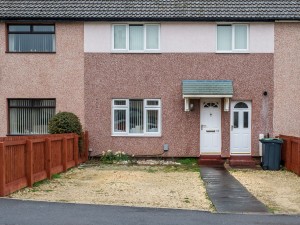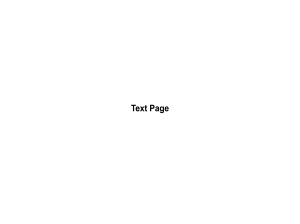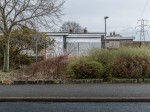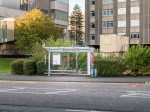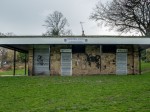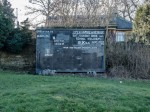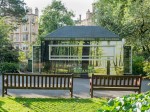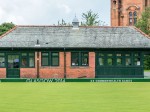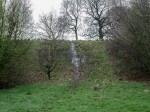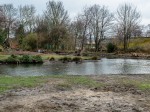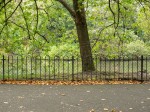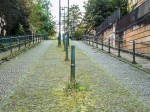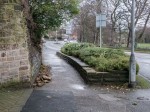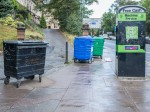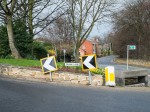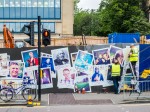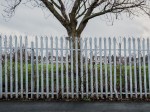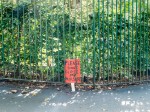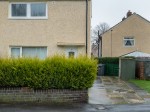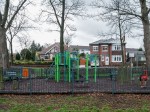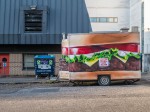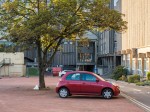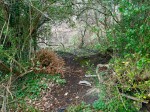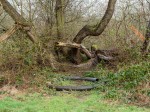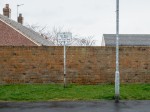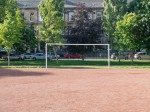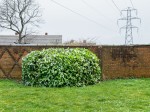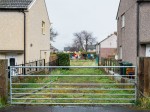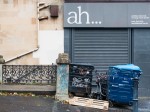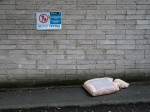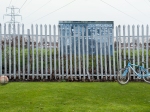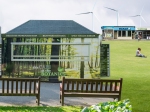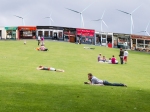Category Archives: 2. Assignments
Assignment 5 Book Layout
This post is in preparation for submitting my 5th and final assignment for my Body of Work. As previously mentioned, the work is now split into two books which are then connected along one edge and then folded to create a single book. My intention at the moment is to send my tutor a PDF of each book and then use the following to explain how they work best when viewed together over a four page spread. Once I have gained feedback on this I will then create a physical ‘dummy’ of the combined books ready for assessment, and then take it to a more professional level within the next module.
Before I start with the layout, I just want to acknowledged that whilst the following shows my intended experience of viewing this book, the advantage of the final product will be that the viewer can decide for themselves how they want to approach it.
The following is the front cover for the combined book, which will have the title ‘Land Values’ below it. To make this work, this front cover will actually be printed onto the rear cover of the Thornhill book (its how the folding works):
When opening this cover you will be presented with two further covers, one for each book. Physically, the one on the left will be the front cover of the Thornhill book, and the one on the right will be the rear cover of the Glasgow book (confusing I know, but please bare with me). The text introduces the concept of values to the way we might value land:
From now on, the Thornhill book (left) will be read from front to back and the Glasgow book (right) will be read back to front – to create the following comparative four page spreads. For this next spread, the blue page is the inside cover and the text is the inner title page alongside my name:
In this first spread the text introduces the two places of Thornhill on the left and Glasgow on the right:
The following shows all the other four page spreads, noting that I have highlighted where text will be placed but the PDF of the final product will need to be viewed to see what the text is.
Assignment 4 Feedback
I was fortunate to gain two sets of feedback for this assignment; firstly from the normal route of my tutor, but also from the inaugural meeting of the new study group set up by and for Scottish students.
In terms of my tutor’s feedback, the two things this has made me think about are to revert the title of my work back to ‘Land Values’, and also to think a little more about the use of words and the impact this can have on the work.
In Assignment 4 I had tested the notion of using a new title, ‘Lost Opportunities’, arguing that the first set of photographs were about looking back at what had been lost from a time and place where I grew up, whereas the second set looked at the present to compare and contrast these losses whilst also considering the opportunities they might present for the future. I did note my own reservations about this when putting these two words together; Lost – Opportunities, which then gave a different connotation of regret that wasn’t something I was particularly intending. My tutor suggested that I might reconsider the title of ‘Land Values’ which I immediately agreed with. It now seems like one of those things where you wonder why you ever deviated from this path. Land Values is, and always has been, at the heart of my Body of Work, is probably the tag towards ‘Sustaining Your Practice’, and is also central to my Extended Written Project.
The next point to consider was the relationship between words and images. I have been quite bereft of words in Assignment 4; including only the title at the front end, then the 12/13 sets of images, and then the artist’s statement at the end. My tutor suggests thinking about including more of a ‘teaser’ at the front end that provides enough for the viewer to realise that the sets of images are meant to work together rather than being a series of independent, mundane images. He also reminded me of the impact I noted from Cloe Dewe Matthews work whereby the ordinary images were given a new life by the introduction of text.
This is another feature of my Body of Work that I had been thinking about. I felt that it lacked something to lift it to something that an audience might be interested to reflect on, but I have always been reluctant to use too much text as I can also see its power to destroy a work if used incorrectly.
With this, I decided to test something with the new Scottish Study Group, and as I quickly introduced each set of images I reintroduced the personal significance of each of the images from my childhood. I was probably being a little unfair with them as some of these images reflect on very specific and personal issues that you would not get just by looking at these images – but was this the missing link that would raise this work? I have, however, always wanted this work to remain fairly ambiguous to allow the audience to reflect and think rather than read them at face value, hence, I feel that my very personal interpretations push the work too far in one specific direction and away from its core purpose of considering ‘Land’s Value’. This is also the sense I got from my test-audience’s reaction – a little too direct and thus confusing as to the overall purpose of the work. I never really got chance to then reintroduce my work from its original perspective but I will look forward to doing this when we meet again.
There are a couple of things that this has helped me to conclude which are that a short introductory piece of text at the beginning of this series is needed, and I am also thinking about adding some words against each image – not as direct as discussed above but something that might allude to this a little more. I intend to give this some more thought, balanced with my concerns over the use of too much text, and probably provide an update in a further blog post.
One specific issue that came from the study group was to consider taking out the set of images of my old and new homes as this directed the work too much towards different social classes, which didn’t seem to fit with the rest of the work. I had used this set as a good stepping off point but I can appreciate this feedback and so need to give this some more thought whilst also making sure that the replacement final set remains sufficiently strong to conclude this series.
I am also pleased to be able to say that I have just finished my substantive draft of the Major Written Project, which has taken up a lot of my time recently, therefore, I should hopefully be able to come back to this Major Body of Work and give it some final and worthy attention. I also want to look into printing options, particularly in terms of producing a book.
BoW Assignment 4
The following is a copy of my fourth assignment for Body of Work. It consisted of the following covering note, a series of paired images that I submitted as a pdf in a book format (I have shown them below as a set of images rather than an attached pdf), and a draft artist’s statement which I intend to put at the end of the book.
Over the last few months I have been ‘getting to know’ my body of work. Strange as that may sound, or at least it is to me, I found that with the previous Assignment 3 submission the work was visually coming together well but that I was struggling to express was it was about both verbally or in writing. I also wanted to create some space between me and the sequence of images so that I could better review the overall work, the pairing of images and their sequencing.
The result has been a refinement to the pairing of images within the body of work and the creation of an artist’s statement to go with it.
I didn’t want to meddle with the work too much as I was concerned not to spoil the flow from overthinking the pairings and sequencing. The main changes are that I have moved away from blackening out parts of some of the images, and I have changed some of the images to the second half of the set.
I thought about the advice from the third assignment which suggested using the blackening out technique on just one image (it had previously been used on 3-4). I gave this a go but felt that it became an odd feature rather than providing a jolt to the viewer. I also felt that I wanted to move away from the idea of using it to politicize my message; therefore, I have drawn away from this idea. I would be interested to have feedback on whether I should perhaps reconsider this strategy.
Regarding the sequencing of images, I have kept the first half of the set identical to Assignment 3, right up to the Glasgow cash machine photo (the twelfth photo in). I liked this sequence and didn’t feel it needed any alterations. After that image, there are various changes including not blackening out, adding a couple of new images, changing some of the pairings, and altering the order a little. I am hoping that this tightens up this second half a little more and is more in keeping with the first half without spoiling what I had already.
With regards to the Artist’s Statement, I have had five attempts at this and have recorded my progress with it on my blog. I thought that I was almost there with it on the fourth attempt but had a slight niggle that I might have over-simplified it. I then picked up a discussion on the OCA forum about artists’ statements which made me decide to look back at it once more and try to refer a little more to the visual culture and context that supports the development of the work. This latest draft is included in this submission.
I have also been thinking about how I might combine this statement within the book format I am proposing for my body of work. As I have mentioned above, one of the things that has troubled me with this work has been that I have struggled to properly explain this work and I think that one of the reasons for this is that even I see different elements within it when I have left it for a while and then come back to it. I don’t want to lose that ambiguity of interpretation for the viewer and worry that including the artist statement up front will lead the viewer too much. I would be more pleased if the viewer was able to appreciate the work from their own perspective before then asking to themselves whether this is what the photographer intended. To achieve this, I am currently planning to include the artist’s statement at the end of the book rather than at the beginning and this is what I have tried to show in the draft pdf of the book that forms the main part of the submission.
Lost Opportunities investigates how changes of time, place, and society can change a person’s relationship with, and appreciation for, both land and the place it forms. It does so by looking back at a Council estate in West Yorkshire where I grew up, and then compares this with the present area I have just moved to in Glasgow.
Images of the Council estate recall ordinary places that have a significance to me, whilst also depicting what I now reimagine as a childhood paradise where I was seemingly free to engage with the land and place oblivious of the threat to this utopia from adulthood and societal influences. The imaginary idealisation of this time identifies with Neo-Romantic principles which regards the past as an integral part of our heritage and national identity and thus something we must preserve, or maybe long for its return.
In Glasgow I wandered around this new place to seek out the heritage I have now adopted, to reflect on its potential of becoming significant to me in the future, and to question whether the idealised notion of a childhood paradise could still be created in this place today. This shift in time, place and society forms a narrative about change, to ask whether it is a threat to the way things were, or the beginning of new opportunities.
Assignment 3: Feedback
This is a quick catch up post on the tutor feedback I received for assignment 3. I am glad to say that the feedback was very positive with a suggestion that I am almost there with the visual aspect of the Body of Work. The next step will be to fine tune some of the pairings and work on an Artist’s Statement to consolidate the connection between statement, images and the contextual studies essay.
I am conscious of not wanting to spoil the Body of Work as it is currently presented by ‘fiddling’ with the image pairings too much, but I do see opportunity for improvement with one or two of them. As for the artist’s statement, this is what I have been struggling with a little; I seem to be able to express my thoughts visually but then struggle a little when trying to put that into words.
Body of Work: Assignment 3
The following text is my reflection on the third assignment of the Body of Work, which accompanies this PDF document of the actual submission images: Lost Opportunities book_2 The PDF needs to be viewed at 2 Page View to appreciate the arrangements.
I also included a full range of other images to give my tutor opportunity to suggest alternative arrangements
Land Values and Lost Opportunities
From the last assignment feedback, the recommendation was to concentrate on developing the new project I had just started around the new area I had moved to in the West End of Glasgow.
This is what I did and set off photographing what caught my eye as a flaneur wandering around this new place. However, as I did this I soon found myself taking a typology type strategy whereby I would collect images based around particular categories of objects. I developed the following classifications to ensure a reasonable collection of photographs to use for this project:
- Neighbours I have yet to meet.
- Land affecting place, and place affecting land.
- Rubbish as landmark for place.
- Pedal power.
- Signs and places.
This strategy was never intended to become the end outcome but more an approach that expressed a sense of place whilst also describing the opportunities to engage or disengage with Land.
As I came to a reasonable end to this project I began to think about how I was going to develop it into my Body of Work which is when I started to move my thoughts towards juxtaposing this element with the Lost project; which is based around the estate I used to live. And so, rather than present this Glasgow West End project as Assignment 3, I have decided to combine it with the Lost project to illustrate where I think this Body of Work is heading.
The PDF document is, therefore, the first attempt at juxtaposing these two sets of images together. I think that there is still some work to go with this but want to use the feedback from this assignment, along with some of the projects in Part 3 of the course notes, to think more carefully about specific pairing of images as well as ensuring that the full set is illustrative of the message I want to portray.
At the same time as putting this together, I have just received feedback from my second assignment for Contextual Studies which confirmed my own concerns that my focus was still a little vague and as a result my literature review was too wide on photographers’ response to society’s relationship with and value for Land. Whilst I haven’t fully addressed this just yet, it has pushed me towards clarifying my intentions for this Body of Work. I have therefore written the following reflection on my Body of Work as I see it at the moment. I was surprised at how difficult it was to write this but I think that this reflected on the vagueness of what was my current thinking and the need to refocus. I hope that the following is a much better explanation of the context behind this Body of Work. I still think, however, that Assignment 3 has more work to go before it fully delivers on this reflection, which I am hoping the feedback from it will give me some pointers towards this.
Reflections on Land Values & Lost Opportunities
This Body of Work reflects on Land as a childhood ‘paradise’ under threat from society’s lack of value for its preservation. This paradise is formed from childhood memories of engaging with Land, and an adult appreciation of the influence this has on personal identity. This Work therefore investigates the threat to this paradise from society and adulthood.
It is influenced by the Neo-Romantic art movement of the 1940’s which similarly looked back at their ‘lost paradise’ formed from a spiritual, mythical, & idealised notion of land, body and society, under threat from the darker forces of war and impending consumerism. Their bond with Land was based around a metaphor of motherhood, nurturing, good and love.
This Work takes an autobiographical approach by retracing a childhood walk around the estate I grew up in, which is then set against a more ambivalent wander around a new place I have still to get to know. The childhood walk considers the impact of adulthood and society on this ‘paradise’ and uses it as a metaphor for humanity’s perceived lost value for and relationship with Land. The adult wander seeks out similar opportunities for engaging with a new Land and a new society to consider whether this ‘paradise’ still exists today.
By juxtaposing images from these two parts of the Work, it develops a conversation on the similarities and differences between these two places, which is then supported by a third dimension; the blackening out of certain features in the childhood walk set. This hints at a political voice in an attempt to engage with the viewer on some of the restrictions; real and perceived, imposed by society on childhood engagement with Land.
While the concept of a childhood paradise is partly based on sentiment and a tendency towards romanticising our memories, the style of the photographs in this Work has purposely avoided a romantic or idealised notion of Land or place. They are thus non-sentimental, straight photographs to represent things as they actually are. This helps to raise an alternative question of whether this childhood paradise actually exists and thus will its loss be missed?
Assignment 2 – Response to Tutor feedback
I wanted to create some space between receiving my feedback for Assignment 2 and writing this response, which is why I am only just writing it now. I found that had become attached to my very specific ideas on Lost, and in this assignment submission I had developed it into a substantive project whereby the next steps would probably have been ones of refinement and editing. I see this now as a crucial decision point between continuing on this very specific journey or taking time out to allow other developments to influence my decisions about the Body of Work. I therefore needed this time and space to break my mind set and come to believe in the advice I was being given.
To set the right tone to what I have tried to describe above, this wasn’t a feeling of rejection on what I had done so far, but much more one of reflection. The general feedback was positive and encouraging in how I had “effectively moved the ideas along very thoroughly” but a core piece of advice was to “put everything else on the backburner for now and go with that momentum [the development of my idea for a new project around the area I now live]” I can see how this might become a further piece of the developing jigsaw without being too transfixed at the moment as to how this will all come together in the final gathering.
The other key message (or word) I took from this feedback was “ambiguity” & the opportunity that this gives to the viewer. This is something I have regularly tried to challenge myself about – having the confidence to be ambiguous, and I am also aware that my proposals for the book to support some of the images in Lost would remove that ambiguity and become a very direct, personal interpretation. I will need to think some more about whether to move on from this book idea, but for now it is resting on the backburner.
My next steps are thus to become a flaneur around the area I have recently moved in to. As I said in my assignment submission, I can see the potential for how this could come together in connection with what I have already done so far. This next assignment submission is, therefore, likely to concentrate on the development of this new idea.
Body of Work: Land Values – Assignment 2
As part of this assignment submission I have given some early thoughts on how I might present these projects, linked to my relationship with a potential audience. This has moved me towards splitting the first project Lost into two parts. The plan for the first part is to prepare a set six images presented as traditional A3 / A2 prints – these are included in this submission as individual photo files. The second part will be presented in book form, which I have presented in this submission as an early draft pdf file (there is a lot more to do to develop this).
The other section of this submission is an update to the project Found. This again will be presented as a series of six traditional A3/A2 prints.
I have decided to drop the third project Modern Society as I felt that it didn’t reflect the direction I was going with the first two projects. I am, however, keeping in mind the process of blackening out objects within a photograph and might recall this as I develop the book for the project Lost.
I am also thinking of replacing this third project with something new. My thoughts are to reflect on my wanderings around the new area I have just moved into in Glasgow. I sense that this could become an interesting comparison with the project Lost, which reflects on the housing estate I grew up in.
The following is my first attempt at writing proper introductions to these projects. It may change, of course, as I develop things further but it has been a useful exercise to do as it begins to link with my considerations for Contextual Studies
———-
This series of three projects presents an autobiographical reflection of my changing relationship with Land, society and personal associations.
The first project: Lost, uses the unreliability of memory and photography in representing the truth, as the basis towards developing a closer yet not totally reliable understanding of my lost engagement with Land, the society I grew up in, and the personal relationship I have with my father.
The project is initially limited to 6 images of the place I grew up in. Their strait aesthetics and limited signifiers towards interpretation are purposely intended to withdraw an audience’s interest and attention. This is an important metaphor for how I tend to limit what I reveal about my past history, thoughts and feelings. It thus becomes representative of my external persona.
My inner thoughts are expressed by presenting a wider range of photographs in book form, which is (will be) carefully hidden within a closed box. This is a comparative metaphor of my hidden, inner-personality which is only revealed when I purposely ‘lift the lid’ to these thoughts and share with those I choose. The photographs in the book reveal more of my thoughts and memories as I walked around the same place I grew up in. More specifically, they also recall a walk I took with my father when I was 7 years old, which I still remember as a significant event in my relationship with him. My thoughts as I retook this walk were tangential; jumping from memories of play, recollections of my free childhood engagement with Land, thoughts about societal change, frustrations about today’s restrictions on opportunities for engaging with Land, and also trying to better understand my father’s faltering concept of reality at that time.
The process of creating this book forms a further discourse on the dichotomy between my natural preference for not revealing my inner-thoughts, and the use of photography as a vehicle towards such revelation. As these inner-thoughts are often more comfortably revealed when in a drunken state I have recreated this state of mind as part of the process towards creation of the book and thus potentially reveal more than I would normally prefer.
———-
The process of creating this book and then hiding it in a box will form part of my further development of this project, following more research and reflection. I want to look into other photographers who have used personal circumstances as part of their body of work (OCA course notes provide helpful reference to Nan Golding, Larry Sultan, Elinor Carucci, Richard Billingham, and Robert Mapplethorpe as good points of initial research). I am also interested in doing more research on surreal photography and how this investigates unconscious thoughts and differing perceptions of reality.
In the above ‘Introduction’ I am proposing to be in a drunken state when I create the book, which is a very radical divergence from my normal relatively controlled approach. If this is a success then I hope it will produce something that is more spontaneous, raw and expressive. I am also aware, however, that I could produce something that completely fails in this endeavour and that I may be trying to be too ambitious. I have decided that I am still going to give this a go and then try to make a detached assessment of its success or otherwise. I will be interested in my tutor’s view on this.
Project 2: Found
My introduction to this project is currently outlined as follows:
———-
This second project: Found has become an important foil to the project Lost, as it allows me to ‘close the lid’ on these inner-thoughts and return them back into their metaphorical box before considering a more mature and newly found sensibility towards Land, my engagement with it, and its intrinsic value.
This is formed from the relationship between the selection of subjects which have obvious signs of a struggle for survival in their natural environment, and the aesthetically appealing composition I have chosen to use.
This choice to aestheticize Land’s struggle for survival is not only intended to be a direct appeal to an audience’s attention but it is also used to highlight the strength of my concern for Land and society’s impact upon it.
———-
In terms of developing this project further, I want to investigate the destructive influence of nature on the fragility of the photograph as a reminder of the subject’s own fragility and struggle for survival. My thoughts on achieving this are to print out the six images and take them back to where they were made, before leaving them there for a day or two. This will give them time to be affected by the potential destructive influence of nature and thus create something unique which might subvert the audience’s attention away from their previous pictorial aesthetic.
Project 3: New
I have changed my focus for this project away from a postmodern appropriated approach of society’s restrictions on our engagement with Land, towards what might at first appear to be a ‘softer’ investigation into the new neighbourhood I have just moved into.
I describe in one of my blog posts that one reason for abandoning this initial idea as part of a standalone project was that it wasn’t quite going in the direction of my other two projects and so I was struggling to keep it connected to them. However, I still have thoughts about how I might merge this into the book for project Lost:
https://paulmmajorproject.wordpress.com/2014/06/01/barriers-to-play/
I have only just started playing with this new project and therefore don’t think it appropriate to include with this submission at this stage. I want to remain free from trying to contextualize it at the moment and thus give it the freedom to develop. Having said that, I have already described in another blog post how this is set out to be contained within three distinct collections, all used to create a sense of place of my new neighbourhood. Ultimately, I expect this project to be drawn back into become a comparative reflection between then and now, and between Lost and New – with Found sandwiched in-between, perhaps.
A sample of images created so far for this project is included in the following post:
https://paulmmajorproject.wordpress.com/2014/06/22/new-project-3-new/
At the moment, I am obviously looking for advice on the two projects as currently presented but perhaps more importantly I am seeking opinion on my proposals for further developing them both.
I am a little concerned that I might be being a little too ambitious with them but then I also feel that it is important to give these ideas a chance. I need to remind myself not to think of these ideas as potential final outcomes to my Body of Work but that they might just be part of the journey towards it. Any wise words around this would be useful.
As part of my progress towards the next assignment submission I want to have created a proper version of the book for Lost (not necessarily the final version), developed my idea for exposing the photographs for Found to the natural elements, and be ready to present something more substantial for the re-worked project New.
Assignment 1: Reponse to Tutor Feedback
Feedback on my first assignment was good and positive, which is always a relief at the start of this final course in the degree programme. The focus of this assignment was about explaining the work you want to take forward for your Body of Work. I received a positive confirmation on this, along with pointers towards things that I might want to consider in order to pull the projects together to create a more cohesive set.
I had asked a specific question about whether or not to progress with all 3 projects that I had proposed, which was affirmed at this stage and until any part significantly pulls ahead. With that in mind, the following is a review of points raised against each project.
Lost
Clive agreed that at the moment this is ‘probably the most complex and fertile’ project but suggested that I might want to think some more about the style of images I was proposing for it. He remarked that ‘there’s more poignancy in revisiting childhood feelings with adult knowledge’. While I liked the un-composed nature of these exploratory photos I also had this niggling doubt myself about how could a middle aged man ever pull off the perception of taking photos through a child’s eyes? I suppose that this would always be false, hence, I am probably conceding on that one and now need to do a little more research before adapting my style on this. The comment about these images being too dark etc was a natural occurrence from the approach I was taking therefore this will be resolved as I approach it from a different perspective. I do know, however, that I want these photos to come across as detached, non-sentimental and void of any overly aesthetic style.
Found
I received some really useful comments on this project which are helping me to contextualise this project and bridge the link with Lost. I now need to think some more about how to do this before my next assignment.
I have come to realise that in Lost I now have three layers running through it, which are:
- My lost relationship with Land.
- My displacement from the society I grew up in.
- My lost relationship with my father – related to a journey around my old estate.
In order to put the project Found on a similar footing I think that I need to develop similar layers, and my developing thoughts at the moment are:
- My re-engagement with Land through photography.
- My developed appreciation for Land’s concerns and its intrinsic beauty.
- My found friendships over the years – related to a journey around Derwent Water, Keswick in the Lake District.
Hopefully as I develop this project Found alongside Lost, with these layers in mind, it will bring about a kind of autobiographical reflection on who I am and where I came from.
Modern Society
Feedback on this was really helpful in clarifying my thoughts on how to progress with this project. It reminded me of my key intention for this which is ‘to remove from images what is keeping us from relating to Land’. I had begun to mix this up with ‘revealing a hidden truth about modern society’. This latter aspect was moving me towards an element of street photography which I know is not where my strengths lie as a photographer, therefore, I agree with Clive to concentrate on the former aspect described here and move away from the images such as Free Money and Surveillance which don’t particularly relate to that.
Overall, nothing specific to respond to other than to use the feedback received to develop the projects towards assignment 2.
Land Values – Assignment 1
Within my blog so far I have explained my thoughts on my initial intentions to investigate the different ways in which we value and engage in Land; how I want to concentrate on a central theme potentially delivered in a variety of ways rather than sticking to a singular genre of style; the type of ideas I have been playing with to investigate their potential; and how I have changed the emphasis of my planned approach towards a more personal reflection on my own relationship with Land and society.
My use of the term ‘Land’ is intended to describe all natural things; such as earth, water, the natural environment and all living things. It does, however, separate out humans from this definition.
These blog posts set out the background, (which I don’t expect a need to repeat here), towards the early development of my ‘Body of Work’.
My central theme still relates to an investigation of how Land is valued by society, but is initially directed towards my own personal relationship with Land (past and present), and then towards making comparisons with how society as a whole seems to have developed a self-imposed imbalance between their own importance and that of Land.
I have currently settled on three strands to this Body of Work with the first two looking at my past and present relationship with Land, and then the third strand looking at modern society and its attempt to distance us from this relationship. I am hoping that I may receive some feedback from my tutor on whether I should retain my focus on all three of these strands or to concentrate my efforts on the first one for now. These three strands to my Body of Work are described against the following three Projects:
Project 1: Lost
As a child I was free to ‘play out’, which generally meant engaging with Land in some way – a free and fascinating resource. The intention of this project is therefore to reflect on how I have lost this relationship, whilst also considering a similarly lost relationship with the society from which I grew up in. I want to do this by taking a journey around my old estate, one that I have not re-visited for over 20 years, and return to the places where I used to play. I intend to base this around a specific journey I took with my father when I was seven years old and thus will also be reflective of the lost relationship I have with my father.
As part of this approach, I decided to embark on a trial run visiting some of my past areas of play within this urban housing estate. It was interesting to note my surprise at the seemingly lack of respect currently given to these areas and of how society had encroached onto many of them.
In relation to the following image taken on this day, I described it on my blog as ‘probably the most significant photo I have ever taken‘, based on its personal connection with an important memory which created its significance for me. I was surprised to realise how powerful this connection was when I compared it to my opinion of all the other photos I have taken as a photographer, and thus my declaration. As I had decided not to explain this significance, a conversation developed (with Clive and Pete) about the impact of ambiguity compared with that of a clear explanation, which was very interesting and insightful on the photographer’s relationship with their audience and how much you need to explain.
The images below add to the one above to illustrate the type and style of photography I am intending to use as a response to this Project. They are intended to be purposely amateurish in style to respond to the impreciseness of memory and the childlike lack of control in which they might respond to memory with a camera.
Project 2: Found
I am now in my mid-forties and some way distant from the childhood freedoms I had. I now acknowledge my own general disengagement with Land, which seems to relate to the aging distance from my childhood and the normal societal pressures of life. I have, however, been encouraged to see how, through photography, I am able to re-kindle my relationship with it. I can use it as an excuse to visit the ‘countryside’ to carry out my investigations of its hidden beauty, away from the control of society’s footpaths and, for a moment, seemingly away from much of its other influence.
I have found that this new found relationship is different to that of my childhood – I am more respectful of it and appreciative of its value.
As I mention on my blog, I have become less inclined to seek out and find the more obvious instrumental values of aesthetic appeal and, as I move towards a belief of Land’s intrinsic value and intrinsic beauty, then I am free to apply my own judgement as what I regard as intrinsically beautiful.
This is what photography has helped me to discover and, with this philosophy in mind, my thoughts for this Project are to investigate this further by reflecting on Land’s struggle to survive against a backdrop of (increasingly) challenging weather conditions, as well as society’s ever-influencing impact on Land.
This Project will be purposely distinct from Project 1, with the photographs reflecting my new found appreciation and value for Land’s intrinsic beauty. The photographs will be more controlled, considerate and respectful of the subject matter (reflecting my current middle age / middle class situation), and they will probably also lack the spontaneity I hope to achieve in Project 1.
The distinctions between Project 1 and Project 2 will be crucial for the set to work with and against each other but my worry at this stage is that they will seem too opposite from each other and thus lose any linkages altogether – another question to ask my tutor.
The following images highlight the style of images that I am thinking of developing for this project:
Project 3: Modern Society
The intention of this project is to move away from the self-reflective perspective and begin to consider the impact of modern society on the way that we might under-value Land. The project is a direct response to my Initial Idea 5, as described on my blog.
The concept is to see how by taking something out a photography we begin to reveal something of the truth about modern society and how it has become a constituent part of our disengagement with Land.
I haven’t progressed this much since playing around with it as part of Idea 5, therefore, the following images are a repeat of those photographs to outline my current thinking on this project.
The blackening out process within each photograph, which is fairly crude at this stage, is intended to reveal a new truth in a slightly more threatening way than say whitening out the object(s).
The following are early examples of this approach:
Summary
These three projects represent my current thinking on how I intend to develop my ‘Body of Work’. They are linked around a central theme of Land values and our diminishing engagement and lack of appreciation of Land’s value or its intrinsic beauty.
If I successfully achieve my aims for each of these projects then I would expect them to form the basis from which I can develop further projects in the future. There is, however, a ‘but’ in this aspiration which relates to my concern that Projects 2 & 3 become too remote from Project 1 and thus diluting the impact of this first project.
Project 1 is much clearer in my mind at the moment and I wonder whether I should concentrate just on this for my Body of Work – Clive, I would appreciate your thoughts on this.
Also, whilst I have been mindful of the different genres and context within which these projects might sit, I have purposely left these thoughts in the background to leave me free to develop the ideas more through my photographic voice for the moment. I do intend to do much more on this later and expect that this consideration, along with my feedback from this assignment, will form the basis from which I develop my next assignment (no.2). For now, the importance to me is being able to express my ideas for these projects to the extent that my tutor is clear of my intentions and can advise me accordingly.

